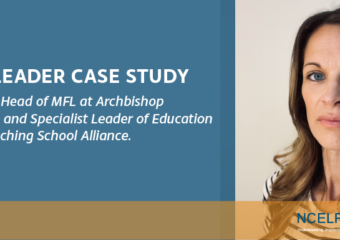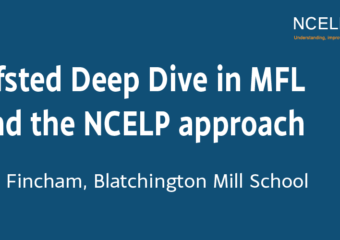From my initial encounter with the work of NCELP in October 2019, I felt this approach addressed a number of issues facing so many MFL teachers I knew and worked with, including myself. A lack of definition in the content of the curriculum and the resulting episodic learning was leading, time and time again, to inconsistent outcomes, disillusionment and demoralisation for teachers and students alike.
Within the NCELP schemes of work, the rigour of the language mapping and the sequencing for effective retrieval and long-term learning goes far beyond any preceding schemes. Knowing that this level of thinking sits behind the curriculum design, as well as it being informed by existing and emerging research, has allowed us to deliver the NCELP curriculum with confidence. Activities are designed to ensure linguistic processing at every stage, with lots of opportunity for deliberate practice. All resources are free and fully adaptable, allowing teachers to personalise and tailor to their own classes.
Having received bespoke training from Rachel Hawkes, our trust staff had time to digest and think deeply about the rationale and research which informs the NCELP approach, and this was hugely beneficial in moving us forward. The impact of this approach has been truly multifaceted, as teachers re-evaluate their practice, engage with referenced research and develop and evolve the learning in their classrooms. Students respond overwhelmingly positively, showing confidence in phonics, independently manipulating grammatical structures, and articulating clearly why and how language fits together. High frequency vocabulary allows students to communicate a range of everyday scenarios and they can do so with a clear sense of ownership and success.
Recently my Year 7 Spanish class were doing La Plaza tiene una torre. They loved it, and 2 little lightbulb moments occurred. Whilst considering what type of text it was, one student asked “why is it un when poema ends in an ‘a'” – we weren’t talking about gender or articles at the time, but the student had not only noticed the gender but felt secure enough in her own knowledge of the rules to question the anomaly. Later when talking about how pasó was in the past tense we had the question from another student ” so how do you say I pass in the present tense then, isn’t it the same? It’s great to see this curiosity developing around linguistic features.
We have been happy to welcome external MFL staff to come and see this learning in action and, as a result, have seen colleagues inspired to try this approach in their own classrooms.




